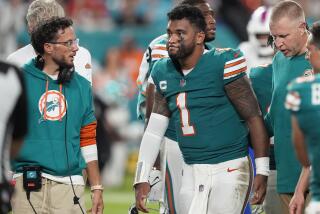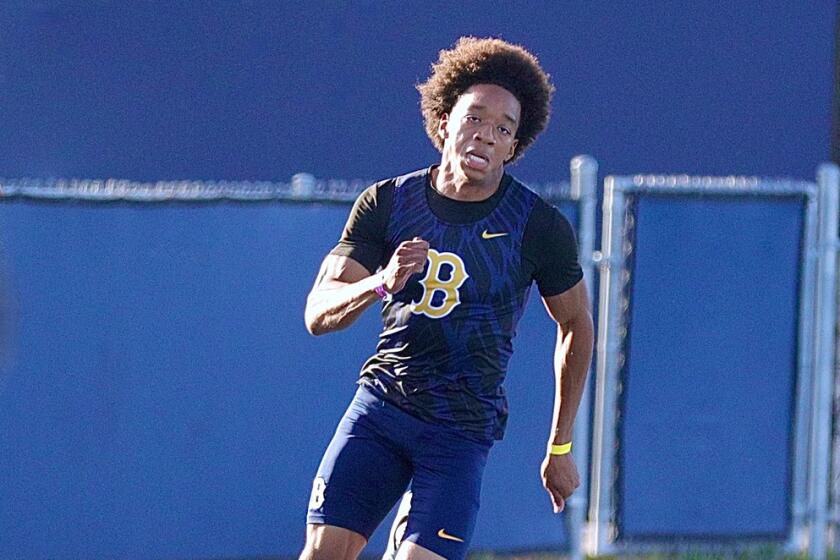A No-Brainer: Football Leads to Concussions : Al Toon Will Attest That Symptoms Can Remain for Years
- Share via
One more reception. “The last catch” as Al Toon now calls it. And one more hit to the head.
“Not a very big hit,” the former New York Jet wide receiver says. But one more concussion. One concussion too many.
Almost three years later and the concentration lapses, irritability, sensitivity to light, sensitivity to movement, dexterity problems, headaches, emotional volatility, dizziness and fatigue continue.
“It’s getting better,” he says. “Now an episode comes, and I take a day, a week or a month off and it passes. They used to last up to three months. For a while there, I was basically laying down in a dark room all day. I was bedridden.”
There have been no assurances of complete recovery. From the outset there was only one more hazy day rolling into the next, and now, upon reflection, Toon acknowledges, “There was a time when I thought of suicide.
“The act itself was never considered, but life was very frustrating,” he says. “I bought a horse farm, and it was the saving grace for me. I spent a lot of time in the barn with the horses. I spent very little time with people.”
Doctors advised him that it would be three months to three years before he would know just how wobbly he would ultimately stand.
“It’s melting away, but very slowly,” he says. “Here you were, a well-trained, mentally sound person, undefeatable, indestructible. . . . It’s almost three years now, and it’s very frustrating. It’s not like you have a broken arm. It’s all internal.
“People approach you, and you are constantly explaining that you just don’t feel good today. I couldn’t have concentrated long enough to have this conversation. Five minutes at the very most.”
Toon was once the highest-paid wide receiver in pro football. For three consecutive years he was selected his team’s most valuable player. He led the league in catches. He played in the Pro Bowl.
He caught the ball over the middle, prided himself in his fierce focus to go after everything and worry about nothing. He suffered one concussion in high school, passed through college without incident, and then became a possession receiver in the NFL, a 6-foot-4 target for linebackers to drill.
“I don’t recall all of the concussions,” he says. “There were more than five and probably less than 20. There was a serious blow my last year in the league, another in the middle of the season and then little bangs that everybody gets in every game.
“It was the cumulative effect of the previous concussions. I remember clearly to this day the doctor saying, ‘You have reached the point where we don’t know what’s going to happen next. You may never recover.’ ”
A sad, sad story?
“Very, very commonplace,” Toon says. “You play the game of football, people get hit in the head. It’s no fluke.”
*
It’s Monday night, time for NFL football, and on ABC-TV there is the dramatic image of two helmets crashing together, the explosion a promise of aggressive entertainment.
“The theme is so strong; this is not a contest between highly trained athletes--this is war,” said Dr. James Kelly, director of the Brain Injury Program at the Rehabilitation Institute of Chicago. “I am appalled at this level of understanding, this encouragement of violence.
“I’m worried that we are going to see something catastrophic happen. I hope not, but this has to be taken seriously. This is your brain. This isn’t Dick Butkus’ knees. This is you as a person and your ability to think.”
Toon, who was left shaken by the game, will not condemn it.
“I don’t think you can take away the spirit, the action, the big hits,” he said. “That’s why the people come out to watch. Maybe you can limit the area of the body that’s being hit. I would eliminate any contact above the shoulders at any position.
“But if you keep taking away the excitement, the game is going to become too vanilla and you will start losing viewers. You lose viewers, then you lose revenue.”
Players are bigger, stronger and faster these days and therefore pack more wallop. Sue Guzman, director of public affairs for the Brain Injury Assn., says the NFL reports there is one concussion suffered in every 3 1/2 games.
“That makes me laugh,” Kelly said. “There may not be a player who goes through a game without suffering a Grade 1 concussion [no loss of memory, but confusion of thought]. It’s getting your bell rung. It’s accepted as part of the game.”
Players who have been knocked out on Sunday are routinely back in the lineup the next Sunday. Some return to the game in which they have been hurt.
“That’s probably not the right thing to do,” said Dr. Daniel Kelly, assistant professor of neurosurgery at UCLA. “It’s clear from our research work that there’s a prolonged period of vulnerability to the brain that might last as long as a month.
“There are a lot of things we do not know yet, but the simplest thing would be to have players sit out a month. Of course, if you did that, you would probably have the quarterback, the running back and the tight ends sitting on the bench.
“The NFL owners would laugh in your face if you suggested that, but research shows a secondary insult in a short period of time is usually more serious and has longer lasting consequences.
“When you accumulate brain damage, it’s like people accumulating the risk of cancer from radiation exposure.”
*
The Brain Injury Assn. reports that 20% of high school players and 10% of college players will suffer a concussion in any given year.
There are three categories of concussions: Grade 1--no loss of consciousness, but confusion without amnesia; Grade 2--no loss of consciousness, but confusion with amnesia; Grade 3--loss of consciousness.
Players do not have to be hit on the head to suffer a concussion. The body can be rotated away from the head resulting in a concussion from an indirect hit.
Helmet on helmet and the head hitting artificial turf cause many concussions.
“Football is a game that will have risk, but there can be work done to narrow that risk,” said Leigh Steinberg, an agent who represents quarterbacks Troy Aikman and Steve Young, both concussion victims. “There can be more rule changes. We protect the punter from even getting touched. Lose a quarterback and a team’s whole season can be lost.”
Earlier this year, Steinberg organized a seminar that featured medical experts from around the country discussing concussions. A month later, the NFL adopted rule changes designed to better protect quarterbacks.
“There should be something more sophisticated in diagnosis than simply asking if a player remembers his name,” Steinberg said. “There should be a neurologist on the sidelines.
“We’re seeing worse concussions today because it’s a simple matter of physics. Players arebigger and are being propelled at each other at faster speeds. We won’t know for years what the impact of this will be. We may have an epidemic of Alzheimer’s and attendant problems 20 years from now with some of these players.”
*
The athlete does not want to talk about concussions or hear about the serious consequences of returning to the field too soon.
“If I went into a locker room, I would be talking to guys who have spent their whole lives getting to the point where they are, and they don’t want to hear it,” Toon said.
“They would rather know: What’s my next contract going to be? They know they can be the next Dennis Byrd [another Jet who was paralyzed by a football collision] or Al Toon, but I understand. They have to keep blinders on if they are going to play and play well.”
James Kelly said the files run deep with athletes who lied to medical personnel, only to step forward on the field, collapse and die.
“That attitude is applauded by the sports industry,” he said. “Isn’t that competitive spirit?”
Management, which has the mission of assembling a winning football team, is also not interested in having its prime performers standing on the sideline.
“There is an ever-present tension in sports medicine between the need of the team to utilize a player and his medical inability to play,” Steinberg said.
*
No answers to lots of questions.
“A lot of high schools and colleges are saying, never send anybody with a Grade 1 back into the game,” James Kelly said. “I’m saying that may be right, but there is nothing in medical literature that supports that.
“Penicillin treats pneumonia, but it’s not like that with concussions. Does bending the rules mean you are going to die? I can’t say that.”
The studies will continue.
“There will be no crowds, no accolades for these athletes when they are 55 and having medical problems because of what happened 20 years earlier,” Steinberg said. “We need to address this now.”
*
Al Toon is 32, married, the father of four and tremendously successful as a businessman just outside Madison, Wis.
“It has been a real struggle, but I can manage my managers now,” he says. “But no way would I be able to manage employees on a daily basis. I couldn’t handle that kind of intensity. There are periods of time when the symptoms are just too pronounced.
“But I have been extremely blessed. I thank God on a regular basis. It’s easy to smile now. I can function. Maybe not 100% the way I functioned before, but I can play with my kids.”
More to Read
Go beyond the scoreboard
Get the latest on L.A.'s teams in the daily Sports Report newsletter.
You may occasionally receive promotional content from the Los Angeles Times.










